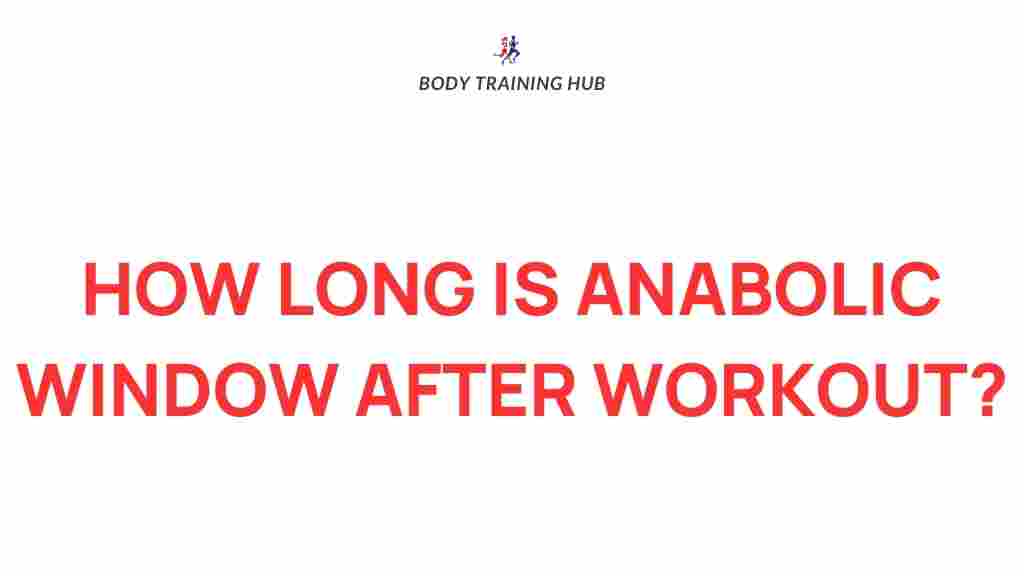Unveiling the Truth: Anabolic Window After Workout
In the world of fitness and bodybuilding, the term anabolic window is often thrown around as a critical period for maximizing muscle growth and enhancing recovery. But what does it really mean? Is it as crucial as some fitness enthusiasts believe? In this article, we will explore the concept of the anabolic window, its significance in post-workout nutrition, and how it affects protein synthesis and exercise recovery. By the end, you will have a clearer understanding of how to optimize your post-workout strategies for better results.
What is the Anabolic Window?
The anabolic window refers to the period after a workout during which the body is primed to absorb nutrients and promote muscle recovery and growth. This timeframe is typically considered to be within 30 minutes to two hours post-exercise. During this critical period, your muscles are more receptive to nutrients, particularly carbohydrates and proteins, which are essential for muscle growth and protein synthesis.
Understanding the anabolic window can help you tailor your post-workout nutrition to maximize exercise recovery and performance gains.
Why is the Anabolic Window Important?
There are several reasons why the anabolic window is deemed significant:
- Enhanced Protein Synthesis: After a workout, your muscles are in a state where they can effectively utilize protein for recovery and growth.
- Glycogen Replenishment: Consuming carbohydrates post-exercise helps restore glycogen levels in your muscles, which is essential for future workouts.
- Hormonal Response: Exercise induces a hormonal response that can enhance nutrient uptake in muscles during the anabolic window.
Maximizing Your Anabolic Window
To make the most out of your anabolic window, follow these steps for effective post-workout nutrition:
Step 1: Timing Your Nutrition
Although the anabolic window is often cited as a short timeframe, recent research suggests that the window may last longer than previously thought. However, to optimize recovery and muscle growth, aim to consume a meal or shake containing protein and carbohydrates within the first 30 minutes to two hours after your workout.
Step 2: Choosing the Right Nutrients
Your post-workout meal should focus on replenishing glycogen and supporting protein synthesis. Here are some options:
- Protein Sources: Whey protein, lean meats, eggs, or plant-based protein powders.
- Carbohydrate Sources: Rice, quinoa, oats, fruits, or sports drinks.
- Healthy Fats: While fats are not essential immediately post-workout, including a small amount can help with overall nutrition.
Step 3: Hydration
Don’t forget about hydration! Replenishing fluids lost during exercise is crucial for optimal recovery. Water is essential, but electrolyte-rich drinks can also be beneficial if you’ve engaged in intense workouts.
Sample Post-Workout Meal Plans
Here are a few examples of effective post-workout meals:
- Grilled Chicken with Quinoa: A serving of grilled chicken breast with a side of quinoa and steamed vegetables.
- Protein Smoothie: A smoothie made with whey protein, a banana, spinach, and almond milk.
- Oatmeal with Nuts: Cooked oats topped with a scoop of protein powder and a handful of nuts or seeds.
Understanding Protein Synthesis
Protein synthesis is the process by which the body repairs and builds muscle after exercise. The availability of amino acids (from protein) and carbohydrates plays a vital role in this process. Consuming adequate amounts of protein after your workout stimulates muscle protein synthesis, leading to greater muscle growth over time.
Troubleshooting Common Post-Workout Nutrition Mistakes
Even with a good understanding of the anabolic window, many individuals make common mistakes. Here’s how to troubleshoot:
1. Skipping Post-Workout Nutrition
Many gym-goers tend to skip meals after workouts due to time constraints or lack of appetite. Skipping post-workout nutrition can hinder recovery and muscle growth. Always plan your meals ahead of time.
2. Overemphasizing Protein
While protein is essential, neglecting carbohydrates can impair recovery. Ensure a balanced intake of both macronutrients.
3. Not Hydrating
Dehydration can impair recovery and performance. Always drink water or an electrolyte drink post-exercise.
4. Waiting Too Long
Delaying your post-workout meal beyond the recommended window can reduce the effectiveness of nutrient absorption. Try to eat within the first hour after exercising.
Real-Life Examples of Effective Post-Workout Nutrition
To illustrate the importance of the anabolic window, let’s take a look at a few real-life scenarios:
Example 1: A Weightlifter’s Routine
John, a dedicated weightlifter, always keeps a protein shake and a banana in his gym bag. After his intense sessions, he consumes this within 30 minutes, ensuring he maximizes his protein synthesis and aids in exercise recovery.
Example 2: A Marathon Runner’s Strategy
Sarah, a marathon runner, opts for a recovery drink that includes both protein and carbohydrates immediately after crossing the finish line. This helps her replenish glycogen stores and prevent muscle breakdown.
Conclusion
The anabolic window is more than just a buzzword in the fitness community; it represents a key period for enhancing muscle growth and facilitating effective exercise recovery. By understanding the importance of post-workout nutrition and timing your meals appropriately, you can optimize your performance and results. Whether you’re lifting weights or running marathons, taking advantage of the anabolic window can lead to significant improvements in your fitness journey.
For additional tips on workout nutrition, check out our comprehensive guide on post-exercise meal planning. Remember, consistency in your nutrition will yield the best results over time!
Stay informed and keep training smart!
This article is in the category Strength & Recovery and created by BodyTraining Team
